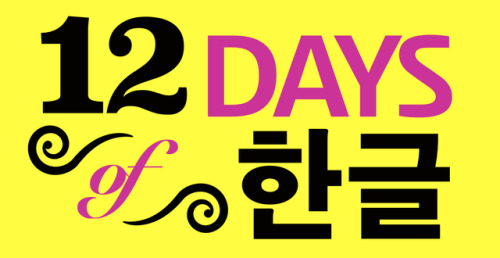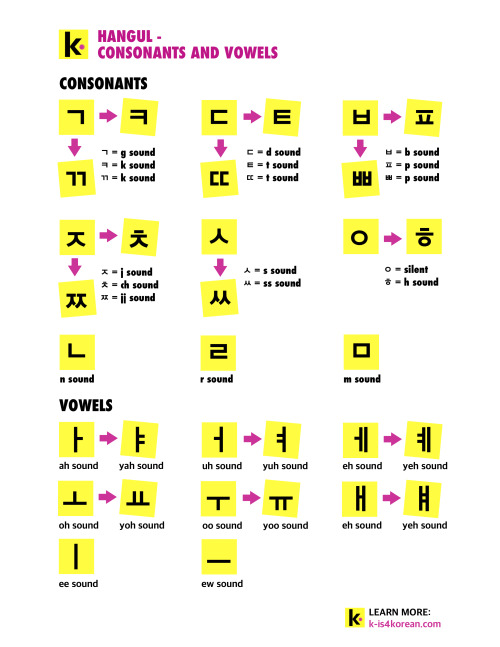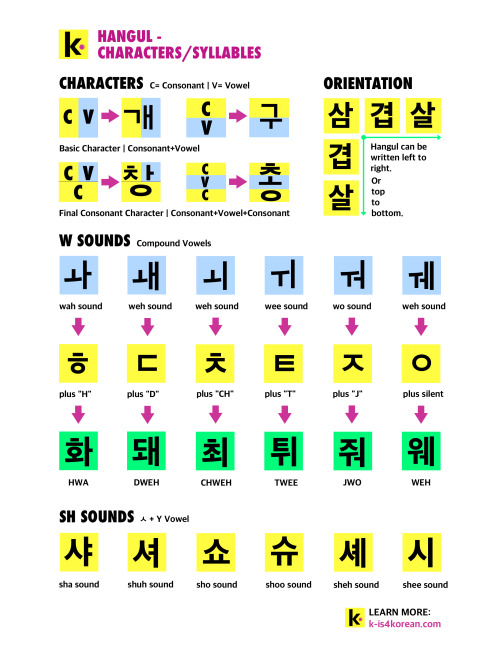#vowels
(near) Open/low front unrounded vowel
This is the vowel used in English “sad”. It exists as an allophone of other vowels in Turkish, Russian, Dutch, Slovak, Swedish and French (as a nasal vowel).
Phonemically, it exists in English, all Arabic languages/dialects, all Berber languages, Somali, Afrikaans, Norwegian, Finnish, Estonian, Latvian, Lithuanian, Danish, Kurdish, Azeri, Persian, Qazaq, Uzbek, Turkmen, Uyghur, Bashkir, Orya, Sinhalese, and in some dialects of Portuguese, Andalusian Spanish, Greek, Romanian.
Post link
12 DAYS OF HANGUL ~ MASTERPOST
Are you beginning to learn Korean? Then you need to learn Hangul! It’s the ingenious Korean alphabet system. Click on the lessons below to get started and learn how to master a new script.
HANGUL LESSONS
[Day 1 ~ Consonants]
Learn the 14 consonants and their sounds.
[Day 2 ~ Vowels]
Learn the 8 Korean vowels and their sounds.
[Day 3 ~ Double Consonants]
5 more consonants to learn.
[Day 4 ~ Y Vowels]
6 unique vowels to round out the alphabet.
[Day 5 ~ Characters]
How to create Korean characters/syllables.
[Day 6 ~ W Sound]
How to form the W sound in Korean.
[Day 7 ~ Sh Sound]
How to form the Sh sound in Korean.
[Day 8 ~ Orientation]
Learn two ways to write with Hangul.
[Day 9 ~ Batchims]
How to read final consonants in syllable blocks.
[Day 10 ~ Linking Sounds]
Linking batchim sounds with proceeding vowels.
[Day 11 ~ English]
How to write English words using Hangul.
[Day 12 ~ Review]
Test your knowledge with this short review.HANGUL DOWNLOADS
[Alphabet PDF]
All the Consonants and Vowels.
[Characters PDF]
How to form characters, Ws, and Shs.
[Advanced PDF]
Batchims, Linking Sounds and English.
Post link
euouae
Euouae’sclaim to fame is as the longest word in the English language which is composed entirely of vowels.
It actually came to be as a mneumonic device in medieval music. There is a portion of the Gloria Patri which is “Seculorum Amen,” and it occurs frequently in the hymn. If you notice, euouaeis the string of vowels pulled directly out of the words: SeculorumAmen.
Instead of writing out the entire phrase every time, music writers would leave euouaeunderneath the notes to indicate to the choir what they were expected to sing.
As described in A General History of the Science and Practice of Music by John Hawkins in 1853: "a word, or rather a compages of letters, that requires but little explanation, being nothing more than the vowels contained in the words Seculorum Amen; and which whenever it occurs, as it does almost in every page of the antiphonary, is meant as a direction for singing those words to the notes of the Euouae.“
This is a series about Dutch and Flemish pronunciation in collaboration with @join-the-dutch-clan. She posts the Dutch ones, I post the Flemish ones :)
(I had to do it via Soundcloud, because the files wouldn’t upload to Tumblr for some reason. But you can find all of the Flemish recordings in the series on my soundcloud!)
Part 1: Vowels & Vowel Combinations (Dutch)
Part 1: Vowels & Vowel Combinations (Flemish)
Part 2: Cosonants (Dutch)
Part 2: Cosonants (Flemish)
Part 3: English Loanwords (Dutch)
Part 3: English Loanwords (Flemish)
Crash Course Linguistics #9 - Vowels
In English, we have 5 (well, sometimes 6) vowel letters, but way more vowel sounds. That’s where the IPA can help us! In this episode of Crash Course Linguistics, we’ll learn about vowels, those sounds you can sing with your mouth open, and how we can represent them clearly using the IPA.
For more with vowels, including practice exercises, check out this week’s issue of Mutual Intelligibility.







